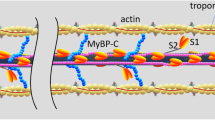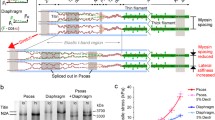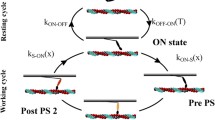Abstract
In sarcomeres of striated muscles the middle parts of adjacent thick filaments are connected to each other by the M-band proteins. To understand the role of the M-band in sarcomere mechanics a model of forces which pull a thick filament to opposite Z-disks of a sarcomere is considered. Forces of actin-myosin cross-bridges, I-band titin segments and the M-band are accounted for. A continual expression for the M-band force is obtained assuming that the M-band proteins which connect neighbor thick filaments have nonlinear elastic properties. On the ascending and descending limbs of the force-length diagram cross-bridge forces tend to destabilize sarcomere while titin tries to restore its symmetric configuration. When destabilizing cross-bridge force exceeds a critical limit, symmetric configuration of a sarcomere becomes unstable and the M-band buckles. Stiffness of the M-band increases stability only if the M-band is anchored to the extra-sarcomere cytoskeleton. Realistic magnitudes of the M-band buckling require that the M-band proteins have essentially nonlinear elasticity. The buckling may explain the M-band bending and axial misalignment of the thick filaments observed in contracting muscle. We hypothesize that the buckling stretches the titin protein kinase domain localized in the M-band being the signal for mechanical control of gene expression and protein turnover in striated muscle.
Similar content being viewed by others
References
Agarkova I, Ehler E, Lange S, Schoenauer R, Perriard JC (2003) M-band: a safeguard for sarcomere stability? J Muscle Res Cell Motil 24: 191–203
Agarkova I, Perriard JC (2005) The M-band: an elastic web that crosslinks thick filaments in the center of the sarcomere. Trends Cell Biol 15: 477–485
Brunello E, Bianco P, Piazzesi G et al (2006) Structural changes in the myosin filament and cross-bridges during active force development in single intact frog muscle fibres: stiffness and X-ray diffraction measurements. J Physiol 577: 971–984
Carlsson L, Yu JG, Thornell LG (2008) New aspects of obscurin in human striated muscles. Histochem Cell Biol 130: 91–103
Cunha SR, Mohler PJ (2008) Obscurin targets ankyrin-B and protein phosphatase 2A to the cardiac M-line. J Biol Chem 283: 31968–31980
Fukuzawa A, Lange S, Holt M et al (2008) Interactions with titin and myomesin target obscurin and obscurin-like 1 to the M-band: implications for hereditary myopathies. J Cell Sci 121: 1841–1851
Granzier HL, Irving TC (1995) Passive tension in cardiac muscle: contribution of collagen, titin, microtubules, and intermediate filaments. Biophys J 68: 1027–1044
Griffiths PJ, Bagni MA, Colombini B, Amenitsch H, Bernstorff S, Funari S, Ashley CC, Cecchi G. (2006) Effects of the number of actin-bound S1 and axial force on X-ray patterns of intact skeletal muscle. Biophys J 90: 975–984
Grove BK, Kurer V, Lehner C et al (1984) A new 185,000-dalton skeletal muscle protein detected by monoclonal antibodies. J Cell Biol 98: 518–524
Hill AV (1953) The mechanics of active muscle. Proc R Soc Lond B 141: 104–117
Hornemann T, Kempa S, Himmel M, Hayess K, Fürst DO, Wallimann T (2003) Muscle-type creatine kinase interacts with central domains of the M-band proteins myomesin and M-protein. J Mol Biol 332: 877–887
Horowits R, Podolsky RJ (1987) The positional stability of thick filaments in activated skeletal muscle depends on sarcomere length: evidence for the role of titin filaments. J Cell Biol 105: 2217–2223
Huxley HE, Brown W (1967) The low-angle X-ray diagram of vertebrate striated muscle and its behaviour during contraction and rigor. J Mol Biol 30: 383–434
Huxley HE, Faruqi AR, Kress M et al (1982) Time-resolved X-ray diffraction studies of the myosin layer-line reflections during muscle contraction. J Mol Biol 158: 637–684
Huxley HE, Stewart A, Sosa H, Irving T (1994) X-ray diffraction measurements of the extensibility of actin and myosin filaments in contracting muscle. Biophys J 67: 2411–2421
Koubassova NA, Tsaturyan AK (2002) Direct modeling of X-ray diffraction pattern from skeletal muscle in rigor. Biophys J 83: 1082–1097
Koubassova NA, Bershitsky SY, Ferenczi MA, Tsaturyan AK (2008) Direct modeling of X-ray diffraction pattern from contracting skeletal muscle. Biophys J 95: 2880–2894
Lange S, Xiang F, Yakovenko A et al (2005) The kinase domain of titin controls muscle gene expression and protein turnover. Science 308: 1599–1603
Leake MC, Wilson D, Gautel M, Simmons RM (2004) The elasticity of single titin molecules using a two-bead optical tweezers assay. Biophys J 87: 1112–1135
Linari M, Brunello E, Reconditi M et al (2005) The structural basis of the increase in isometric force production with temperature in frog skeletal muscle. J Physiol 567: 459–469
Liversage AD, Holmes D, Knight PJ et al (2001) Titin and the sarcomere symmetry paradox. J Mol Biol 305: 401–409
Luther P, Squire J (1978) Three-dimensional structure of the vertebrate muscle M-region. J Mol Biol 125: 313–324
Obermann WM, Gautel M, Steiner F et al (1996) The structure of the sarcomeric M band: localization of defined domains of myomesin, M-protein, and the 250-kD carboxy-terminal region of titin by immunoelectron microscopy. J Cell Biol 134: 1441–1453
Puchner EM, Alexandrovich A, Kho AL (2008) Mechanoenzymatics of titin kinase. Proc Natl Acad Sci USA 105: 13385–13390
Schoenauer R, Bertoncini P, Machaidze G et al (2005) Myomesin is a molecular spring with adaptable elasticity. J Mol Biol 349: 367–379
Schoenauer R, Lange S, Hirschy A et al (2008) Myomesin 3, a novel structural component of the M-band in striated muscle. J Mol Biol 376: 338–351
Sosa H, Popp D, Ouyang G, Huxley HE (1994) Ultrastructure of skeletal muscle fibers studied by a plunge quick freezing method: myofilament lengths. Biophys J 67: 283–292
Telley IA, Denoth J, Stüssi E et al (2006) Half-sarcomere dynamics in myofibrils during activation and relaxation studied by tracking fluorescent markers. Biophys J 90: 514–530
Tsaturyan AK, Koubassova N, Ferenczi MA et al (2005) Strong binding of myosin heads stretches and twists the actin helix. Biophys J 88: 1902–1910
Trombitás K, Tigyi-Sebes A (1984) Cross-bridge interaction with oppositely polarized actin filaments in double-overlap zones of insect flight muscle. Nature 309(5964): 168–170
Vilfan A, Duke T (2003) Instabilities in the transient response of muscle. Biophys J 85: 818–827
Wakabayashi K, Sugimoto Y, Tanaka H et al (1994) X-ray diffraction evidence for the extensibility of actin and myosin filaments during muscle contraction. Biophys J 67: 2422–2435
Zahalak GI (1997) Can muscle fibers be stable on the descending limbs of their sarcomere length-tension relations? J Biomech 30: 1179–1182
Author information
Authors and Affiliations
Corresponding author
Rights and permissions
About this article
Cite this article
Shabarchin, A.A., Tsaturyan, A.K. Proposed role of the M-band in sarcomere mechanics and mechano-sensing: a model study. Biomech Model Mechanobiol 9, 163–175 (2010). https://doi.org/10.1007/s10237-009-0167-0
Received:
Accepted:
Published:
Issue Date:
DOI: https://doi.org/10.1007/s10237-009-0167-0




